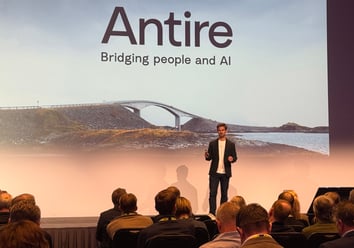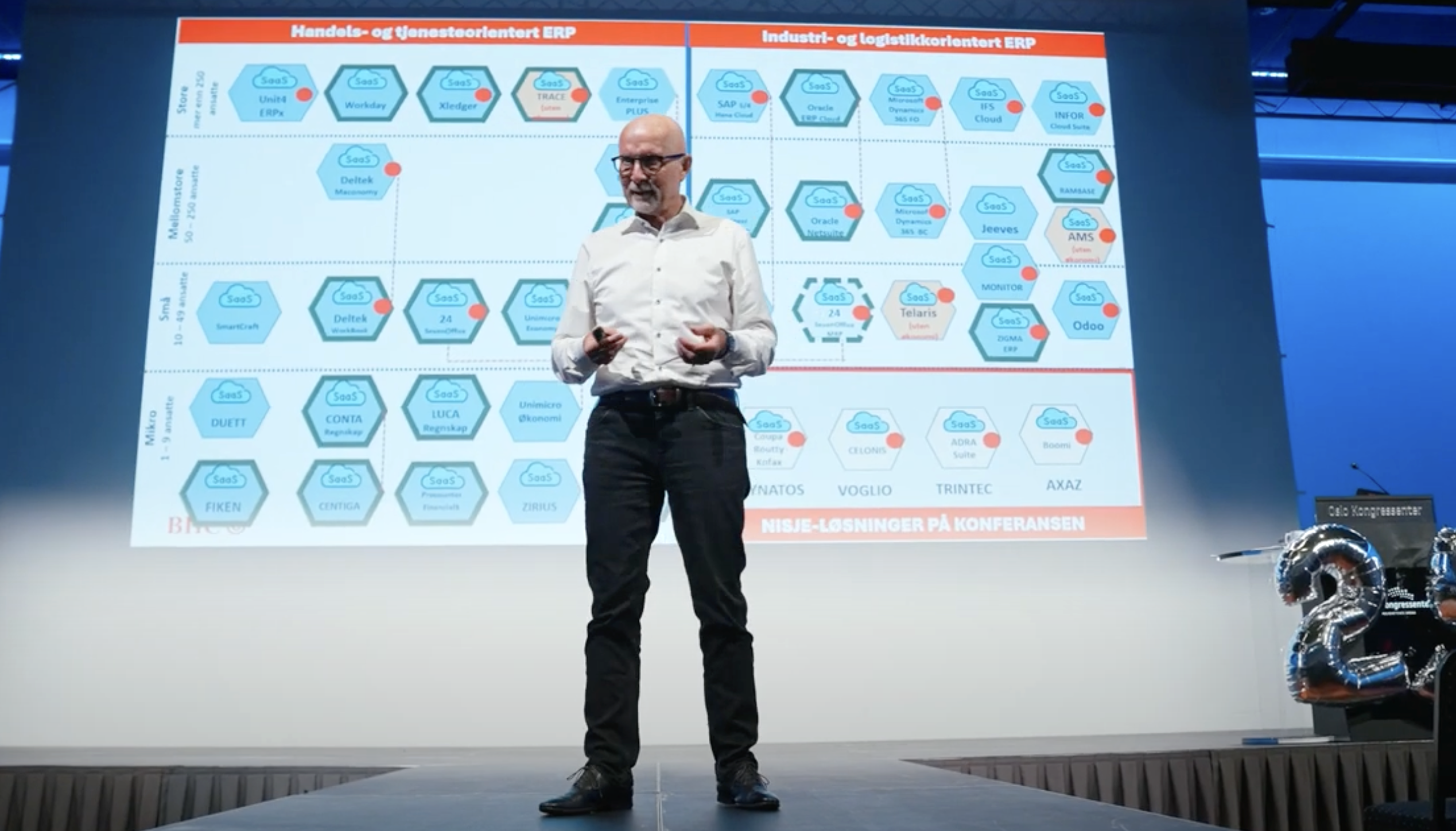AI made ERP great again
AI Business Agents Lead

The AI Shift in ERP: What I Learned at ERP 2025 Conference
By Laura Visuerte Almagro, AI Business Agents Lead at Antire
After years as an ERP solutions architect, I've watched technology trends come and go. But over the past year, something fundamental changed. Every ERP meeting now includes AI discussions. So, of course, at this year’s ERP 2025 Conference in Oslo, one of the biggest focus areas was the role of AI in ERP.
Bo Hjort Christensen provided his usual in-depth analysis of ERP systems and the ever-evolving ERP landscape. He also touched on how AI is shaping the future of enterprise solutions.
However, I want to highlight the session by Antire’s Chief Commercial Officer, Mats Foss Knutsen, who presented our progress in this field and shared practical examples of how AI can transform ERP environments.
As someone now building these AI solutions at Antire, I want to share what resonated most with conference attendees and what it means for organizations evaluating their ERP strategies.
The new complexity in ERP selection
The traditional ERP evaluation criteria remain important: industry fit, scalability, integration capabilities, and total cost of ownership. However, the conference made clear that AI capabilities have become equally critical. This adds complexity to an already complex decision, yet it also opens possibilities we couldn't imagine just two years ago.
Organizations are discovering that ERP systems selected recently using traditional criteria now face new questions. Can the system integrate with modern AI platforms? Does it provide the data access and APIs necessary for AI solutions to function effectively? Can you implement focused AI capabilities without massive customization projects?
The good news from the conference is that you don't need to replace your entire ERP to benefit from AI. At Antire, we've successfully deployed AI solutions across different platforms, including NetSuite, Azure, Google, Oracle, and others, often starting with specific pain points that don't require touching core ERP functionality. The key is choosing an approach and architecture allowing gradual enhancement rather than wholesale replacement.
The traditional ERP evaluation criteria remain important: industry fit, scalability, integration capabilities, and total cost of ownership. However, the conference made clear that AI capabilities have become equally critical.
Why 95% fail and what the successful 5% do differently
Both Mats' presentation and our colleague Peyman's recent article, Making Data Smart: Key insights on how to create business value with AI, addressed a sobering reality: 95% of AI agent projects never reach production. Having built AI solutions that actually deliver value, I've observed clear patterns that separate success from failure.
The failures typically start by trying to find a problem for their solution (AI) rather than finding solutions for their problems. Many organizations aim for sweeping transformation instead of focusing on targeted improvements. They prioritize advanced features over user adoption. In contrast, successful projects start with clearly defined, measurable problems where even small wins deliver real value.
Our Expense Report Agent perfectly illustrates the Antire approach to building successful AI. It started simply as a way to create expense reports from your phone. However, as we refined it based on user needs, it evolved into a Norwegian tax expert who understands the complexities of Norwegian expense regulations. It knows that business dinners with different alcohol percentages have different tax implications, understands representation costs, and correctly categorizes software purchases. This evolution from simple tool to intelligent assistant shows how starting small and building iteratively creates real value.

Pictured above: Bo Hjort Christensen giving a deep dive into the ERP landscape at ERP 2025.
The Norwegian context and why copilots fall short
Mats’s presentation also highlighted why generic copilot solutions consistently underperform in Norwegian organizations. While copilots can be helpful for proof-of-concept demonstrations, organizations quickly discover that people won't use them if they're not tailored to specific needs. It's hard to extract real ROI or business value from generic solutions that don't address the particular requirements of Norwegian businesses.
Mats illustrated this with concrete examples during his presentation. International AI models don't understand Norwegian regulatory requirements, industry terminology, or business practices. They might process information correctly from a technical standpoint, but miss crucial details required for Norwegian compliance and reporting.
Take our timesheet controller solution as an example. It understands the time writing rules of each specific company, flags timesheets that aren't compliant, and comprehends flexi-time rules, offshore regulations, overtime calculations, and all Norwegian-specific requirements with consistency. This level of specificity and reliability is difficult to achieve with copilots, where you can't see "under the hood" to understand how decisions are made. Organizations often spend more time managing and correcting copilot outputs than they save, resulting in a less stable solution that frustrates users rather than helping them.
Want to get more value from your ERP investments. Visit our AI Value Center page here.
Three levels of AI maturity in practice
The framework presented at the conference aligns with what we've seen in real implementations. Organizations progress through three levels, and understanding this progression helps set realistic expectations:
- Level 1: Assistive AI automates routine tasks and answers basic questions, handling perhaps 20% of specific work. This includes data extraction, report generation, and simple decision support.
- Level 2: Augmented AI understands business context and connects disparate information, managing 20-40% of tasks. Our digital marketing solution operates here, analyzing campaign data across platforms and providing strategic recommendations based on both data patterns and business objectives.
- Level 3: Autonomous AI completes 60-80% of defined processes within established parameters. Few organizations have reached this level, but those that have see dramatic efficiency gains.
The key lesson from the conference: you can't skip levels. Each builds the technical capabilities and organizational confidence necessary for the next.
Making smarter ERP decisions in an AI world
For organizations evaluating ERP systems today, the conference offered clear guidance on what to consider beyond traditional criteria.
Begin with the bigger picture: the integration architecture, not only the APIs. Can the system expose data in ways AI solutions can consume? How difficult is it to implement custom integrations? Systems with flexible architectures enable rapid AI deployment, while others require extensive middleware investments.
Second, evaluate the depth of AI integration vendors offer. AI chatbots can be useful as a phase one implementation, helping organizations get comfortable with AI and demonstrating initial value. However, the real ROI comes from complete AI integration that goes beyond conversation interfaces to transform business processes. Look for partners who can guide you from initial chatbot implementations through to sophisticated AI solutions that deliver measurable business results.
Third, consider the pace of innovation. If implementing a simple automation requires months of vendor consultation, you'll struggle to keep pace with competitors who can deploy new solutions in weeks. The ability to iterate quickly increasingly determines competitive advantage.
The opportunity hidden in complexity
While the added complexity of AI considerations makes ERP selection more challenging, it also presents unprecedented opportunities to enhance how organizations work. We're not just digitizing paper processes anymore; we're building intelligence that actively assists users in their daily tasks.
At Antire, we focus on creating AI solutions that enhance human capabilities. They handle the repetitive, error-prone tasks that drain productivity, freeing people for work requiring creativity, relationship building, and strategic thinking. The complexity of choice leads to simplicity of operation.
One thing is abundantly clear: the ERP conversation has permanently shifted. AI is no longer a future consideration but a present reality that affects every implementation decision.
Your next steps matter more than ever
The ERP 2025 Conference made clear that organizations face a critical decision point. They can treat AI as an optional add-on, likely joining the 95% whose projects never deliver value. Or they can recognize that AI fundamentally changes what's possible and plan accordingly.
This doesn't mean abandoning your current ERP or embarking on massive transformation projects. It means thoughtfully evaluating where AI can deliver immediate value, choosing partners with proven implementation experience, and building success gradually through focused solutions.
For Norwegian organizations, this also means working with partners who understand local requirements. Success requires AI solutions built with Norwegian context embedded from the start, not added as an afterthought. The difference between a generic solution and one that understands your specific business context is the difference between a tool that sits unused and one that transforms daily operations.
At Antire, we've learned these lessons through actual implementation. We know what works because we've built it, deployed it, and measured the results across multiple ERP platforms and industries. The path from concept to production doesn't have to be lengthy or risky when you work with experienced partners using proven methodologies.
The conversation has permanently changed
Leaving the conference, one thing was abundantly clear: the ERP conversation has permanently shifted. AI is no longer a future consideration but a present reality that affects every implementation decision. Organizations that recognize this shift and act accordingly will find themselves with systems that don't just record what happened but actively help shape what happens next.
Your ERP choice today determines your competitive capabilities tomorrow. But with the right approach, the right partners, and realistic expectations, the added complexity of AI considerations leads to dramatically enhanced capability. Processes become smarter, decisions become better informed, and work becomes more focused on what humans do best.
The opportunity to transform how your organization operates has never been greater. The question isn't whether to incorporate AI into your ERP strategy, but how to do it effectively, with partners who understand both the technology and your specific context.
Curious about what AI agents could do for your business? Drop me an email, I’d love to chat.

Where do you want technology to take you?
Get in touch
